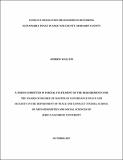| dc.contributor.author | Wallum, Andrew | |
| dc.date.accessioned | 2018-03-08T11:18:58Z | |
| dc.date.available | 2018-03-08T11:18:58Z | |
| dc.date.issued | 2017 | |
| dc.identifier.uri | http://hdl.handle.net/123456789/282 | |
| dc.description.abstract | African societies and the developing countries have been undergoing difficult times in terms of
ethnic and clan conflicts and antagonism. The northern part of Kenya especially Marsabit is
infamous for the frequent conflicts and counter conflicts as communities are pitied against each
other despite the numerous high profile conflict resolution mechanism processes employed year
after year. The study was guided by the objectives of how methods of conflict resolutions, the
role of women in conflict relation mechanisms and the challenges faced in restoring sustainable
peace in Saku sub-county. The study was significant in that sustainable peace has not been
realised despite the efforts being employed. Study was guided by Kumar Rupesinghe theory of
conflict transformation model and Edward Azar’s theory of Protracted Social Conflict (PSC)
theory. A cross-sectional design was used to target community conflicts in Saku. Purposive and
random sampling techniques were employed in this study to collect data from respond ents. The
data collection instruments were questionnaire and interview guide which were tested for
reliability and validity before being administered on different respondents. The quantitative data
collected by questionnaire was processed, analysed by the Statistical Package for Social Sciences
(SPSS version 11.5) and finally presented in frequency tables, graphs and charts. The qualitative
data collected by interview guide was evaluated, classified into logical thematic categories based
on the objectives of the study and a description of the phenomenon. The study found out that
traditional method of conflict resolution processes was the most preferred; women should take
active role in conflict resolutions processes; challenges in peace processes include scramble for
inadequate resources, possession of illegal arms, ethnic political incitement; inadequate skill
levels of negotiators/mediators. The study concludes that the main cause of conflict is scramble
for pasture and water, that the indigenous method of conflict resolution need to be employed, and
that the government and other stakeholders should take into consideration the above. Finally
several recommendations were made including the use of traditional methods of conflict
resolution; need for the government to make their presence felt in the entire county and provide
security to the citizens; involvement of all stakeholders in peace processes and disarmament
programmes. | en_US |
| dc.language.iso | en | en_US |
| dc.publisher | Africa Nazarene University | en_US |
| dc.subject | Conflict resolution mechanisms | en_US |
| dc.subject | Restoring sustainable peace | en_US |
| dc.title | Conflict Resolution Mechanisms in Restoring Sustainable Peace in Saku Sub-County, Marsabit County | en_US |
| dc.type | Thesis | en_US |

